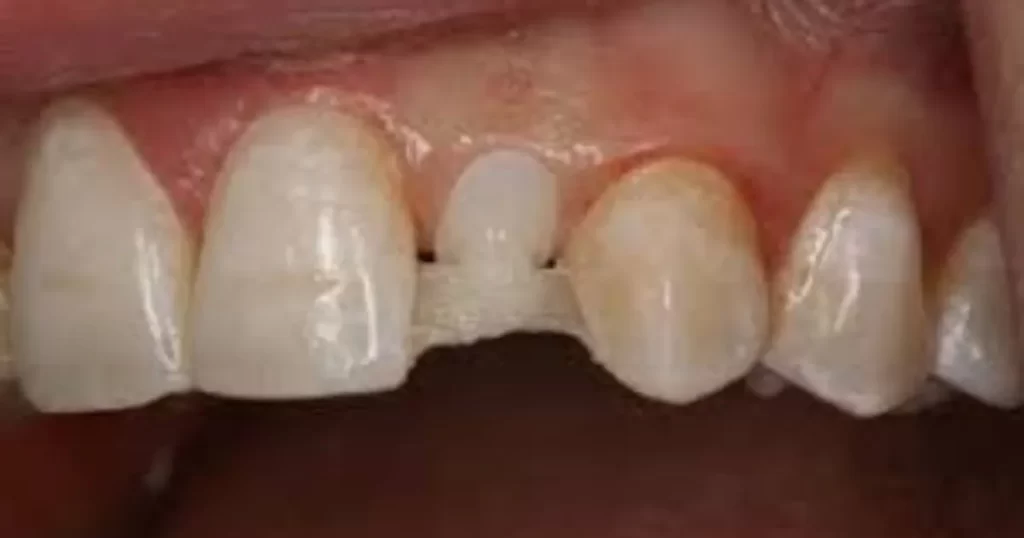Composite Bridges
- Home
- Dental Bridges
- Composite Bridges
Losing a tooth can be a distressing experience that affects your confidence, self-esteem, and ability to eat and speak properly. Fortunately, modern dentistry offers a variety of solutions to replace missing teeth, restore oral function and aesthetics, and improve your quality of life. One such solution is composite bridges, which are dental prostheses made of tooth-colored composite resin that can be bonded to your existing teeth.
We will explore what composite dental bridges are, how they work, their advantages and disadvantages, and what to expect during the treatment process.

Dental composite bridges, also known as bonded bridges, are dental prostheses that replace missing teeth by bonding artificial teeth to your existing teeth with a special type of dental adhesive. Unlike traditional bridges that rely on crowns or metal frameworks to hold the artificial teeth in place, composite bridges use a strong and durable composite resin that is custom-colored to match the natural shade of your teeth.
One of the unique features of composite bridges is that they do not require any significant modification of your existing teeth, as they can be bonded directly onto the enamel without the need for extensive drilling or preparation. This makes composite dental bridges a minimally invasive and conservative option that preserves your natural teeth and reduces the risk of complications and sensitivity.
Another advantage of composite bridges is that they can be used to replace one or more missing teeth, depending on your individual needs and preferences. This makes them a versatile and flexible solution that can be customized to match your unique oral situation.
One variation of dental composite bridges is Ribbond composite bridges, which use a special type of fiber reinforcement to provide additional strength and stability to the prosthesis. Ribbond is a biocompatible and ultra-thin ribbon of fiberglass that can be incorporated into the composite resin to reinforce the bond between the artificial tooth and the natural tooth. This results in a stronger and more durable bridge that can withstand the forces of chewing and speaking without breaking or chipping.
Ribbond composite bridges are particularly useful in cases where the natural tooth structure is compromised or weakened, as the reinforcement fibers can provide additional support and protection. Ribbond composite bridges can also be used in cases where traditional bridges are not an option due to the lack of sufficient tooth structure or the presence of metal allergies.
There are several advantages to choosing dental composite bridges as a dental prosthetic solution:
Aesthetics: Composite bridges are custom-colored to match the natural shade and shape of your existing teeth, resulting in a seamless and natural-looking smile that enhances your appearance and self-confidence.
Minimally invasive: Composite bridges do not require significant drilling or preparation of the natural teeth, which means that more of the tooth structure is preserved, reducing the risk of sensitivity, discomfort, and damage.
Versatility: Composite bridges can be used to replace one or more missing teeth, depending on your needs and preferences, making them a flexible and adaptable solution.
Durability: Composite bridges are strong, durable, and long-lasting, especially when reinforced with Ribbond fibers.
Cost-effective: Composite bridges are generally less expensive than other types of dental prostheses, such as implants or traditional bridges, making them a more affordable option for many patients.
While dental composite bridges offer many benefits, there are also some disadvantages to consider:
Limited lifespan: Composite bridges are not as durable as other types of dental prostheses, and may need to be replaced every 5-7 years, depending on the individual situation.
Maintenance: Composite bridges require regular cleaning and maintenance to prevent decay, discoloration, and other problems. This may include daily brushing and flossing, as well as regular dental checkups and cleanings.
Not suitable for all cases: Composite bridges may not be suitable for patients with significant tooth decay, gum disease, or other oral health issues that require more extensive treatment.
Susceptible to staining: While composite resin is stain-resistant, it may still become discolored over time due to exposure to certain foods, drinks, and habits, such as smoking.
Requires a skilled dentist: Composite bridges require a high level of skill and expertise to design, prepare, and bond effectively, which means that not all dentists may be qualified to perform the procedure.
f you are considering composite bridges as a dental prosthetic solution, it is important to understand what to expect during the treatment process. The process typically involves the following steps:
Consultation: Your dentist will examine your teeth and gums, review your medical history, and discuss your goals and preferences to determine if composite bridges are a suitable option for you.
Preparation: If composite bridges are deemed appropriate, your dentist will prepare the natural teeth by cleaning and roughening the surfaces to enhance the bond strength. They may also take impressions of your teeth to create a customized bridge that fits snugly and comfortably.
Bonding: Once the bridge is ready, your dentist will apply a special dental adhesive to the prepared teeth and carefully position the bridge in place. They will then use a curing light to harden the resin and secure the bridge to the teeth.
Polishing: After the bonding process is complete, your dentist will polish the composite resin to ensure a smooth and natural-looking finish.
Follow-up: You will be instructed on how to care for your composite bridge, including proper brushing, flossing, and regular dental checkups. Your dentist may also schedule follow-up appointments to monitor the health and function of the bridge and make any necessary adjustments or repairs.
Dental composite bridges are a modern and effective solution for replacing missing teeth and restoring oral function and aesthetics. With their natural-looking appearance, minimal invasiveness, and flexibility, composite bridges offer many advantages over traditional bridges and other types of dental prostheses. However, it is important to consider the potential disadvantages and to work with a skilled and experienced dentist who can provide high-quality care and support throughout the treatment process.
If you are interested in learning more about composite bridges and whether they are a suitable option for you, please contact your dental office to schedule a consultation.

